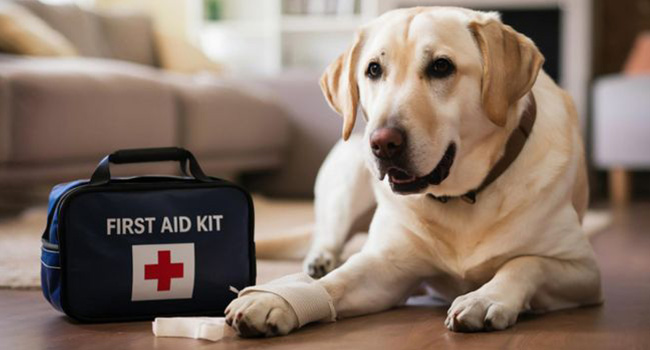

Emergencies can strike at any moment, and when it comes to our beloved pets, quick and effective action can make all the difference. Knowing how to administer basic first aid at home can be crucial in stabilising your pet's condition before professional help is available. Whether it's a minor injury or something more serious, being prepared with the right knowledge and tools can save your pet's life. Here, we’ll explore essential tips for handling common pet emergencies at home, ensuring you're equipped to provide the best care when your furry friend needs it most.
Pet first aid involves immediate care given to a pet who is injured or suddenly taken ill. While it’s not a substitute for veterinary care, it can prevent a situation from worsening until you can get your pet to a vet. It’s essential to have a well-stocked pet first aid kit and know how to use it effectively.
Every pet owner should have a first aid kit specifically for their pet. It should be kept in an easily accessible location and checked regularly to ensure all items are up to date and in good condition. Here’s what your kit should include:
Bandages and Gauze: For covering wounds and stopping bleeding.
Adhesive Tape: To secure bandages in place.
Scissors: For cutting bandages and gauze to the appropriate size.
Tweezers: To remove foreign objects like splinters or ticks.
Antiseptic Wipes or Solution: To clean wounds and prevent infection.
Digital Thermometer: To monitor your pet’s temperature.
Hydrogen Peroxide: Used to induce vomiting in certain poisoning cases, under vet guidance.
Muzzle: For your pet’s safety, as they might bite when in pain.
Gloves: To protect yourself while administering first aid.
Emergency Contact Information: Including your veterinarian and the nearest emergency pet clinic.
Being able to identify when your pet is in distress is crucial. Some emergencies are immediately obvious, while others might be more subtle. Here are some common scenarios where first aid might be necessary.
If your pet is bleeding, the first step is to apply pressure to the wound using a clean cloth or gauze. Hold it in place until the bleeding slows down. If the wound is on a limb, you can gently elevate the area to reduce blood flow. If the bleeding is severe or doesn’t stop within a few minutes, seek veterinary care immediately.
Choking is a terrifying situation that requires swift action. If your pet is struggling to breathe, pawing at their mouth, or making choking sounds, they might have something lodged in their throat. First, open their mouth to see if you can remove the object with your fingers or tweezers, but be careful not to push it further down. If this doesn’t work and your pet is still choking, perform the Heimlich manoeuvre by applying quick pressure to the abdomen just below the ribcage. If the object is dislodged, take your pet to the vet to ensure no internal damage has occurred.
Pets are naturally curious, and they might ingest something toxic if given the chance. Common household items like chocolate, certain plants, and human medications can be deadly. If you suspect your pet has ingested something poisonous, don’t induce vomiting unless instructed by a vet. Instead, contact your veterinarian or a pet poison helpline immediately and be ready to provide information about the substance, how much was ingested, and when it happened. Keeping hydrogen peroxide in your first aid kit can be useful, as it’s sometimes recommended by vets to induce vomiting in certain cases.
Witnessing your pet having a seizure is a frightening experience. During a seizure, it’s important to keep your pet safe from injury by moving them away from hard or sharp objects. Don’t try to restrain them or put anything in their mouth. Instead, focus on timing the seizure and keeping the environment calm. After the seizure has ended, comfort your pet and contact your veterinarian for further guidance.
Burns can occur from contact with hot surfaces, chemicals, or electrical sources. For minor burns, cool the area with cold water for several minutes and then cover it with a non-stick bandage. Avoid using ice or applying ointments, as they can cause further damage. For more severe burns, seek veterinary attention immediately.
Being prepared for a pet emergency involves more than just having a first aid kit. It’s also about being educated on how to respond in various situations. Consider taking a pet first aid course to learn hands-on techniques and strategies for handling emergencies.
Moreover, keep a list of emergency contact numbers, including your regular vet and the nearest 24-hour emergency clinic, in a prominent place. Knowing where to go and who to call can save precious time in a crisis.
Pet first aid is an essential skill for every pet owner. While we hope you never have to use it, being prepared can make all the difference in an emergency. Remember, the goal of first aid is to stabilise your pet and prevent the situation from worsening until you can reach professional care.
At Eden Pets Care, we prioritise the health and well-being of your pets. Our experienced team is here to provide the best possible care, whether it's through routine check-ups or emergency services. To learn more about how we can support you and your furry friends, visit our website or contact us today. Don’t wait for an emergency to strike—be prepared with Eden Pets Care by your side.